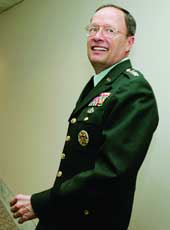Hard sell

NSA's tech reorg faces uphill road to win over critics.
With the recent appointment of Prescott Winter to the new position of chief technology officer, the National Security Agency is moving to revitalize how it plans for and buys technology. All signs indicate the road he will travel won't necessarily be an easy one.Security experts say the agency faces skepticism in Congress about the effectiveness of its new technology transformation effort, dubbed Turbulence, which aims to give the agency tools to fight terrorism in cyberspace and conduct surveillance of new digital communication devices globally.NSA also must overcome lingering doubts related to missteps with its canceled multibillion-dollar technology modernization program, Trailblazer. It also faces scrutiny from civil liberties advocates about NSA technologies used in controversial wiretapping authorized by President Bush."There are operational issues [for Congress] and also issues of whether there are adequate controls to ensure the activity is within the law," said Lisa Graves, deputy director of the Center for National Security Studies, a civil liberties advocacy group.NSA Director Lt. Gen. Keith Alexander named Winter to the new post as part of an internal reorganization, according to an April 4 memo obtained by the Baltimore Sun. It is the first major shake-up by Alexander since he arrived at the agency in August 2005. Winter is a career NSA employee and former head of its Commercial Solutions Center, which works with companies in the private sector. NSA officials and Winter declined to comment.Under the reorganization, technology developments at the NSA will be consolidated under Winter, whose priorities are expected to include getting Turbulence under control and resolving the agency's growing problem with limitations on power available to run its expanding information technology systems, according to the memo and other internal documents obtained by the Sun.Turbulence, which is mostly classified, is the successor to Trailblazer, a five-year program to modernize the agency's Cold War surveillance technologies. When Alexander arrived, Trailblazer was experiencing cost overruns in the hundreds of millions of dollars and an overall price tag in excess of $1 billion, and he canceled the program. Science Applications International Corp. performed most of the work on Trailblazer.Alexander initiated Turbulence as a conglomeration of smaller programs pursuing similar goals as Trailblazer. Only 18 months old, it already is considered troubled, but because its budget is not consolidated, some lawmakers wonder if the problems have been fully vetted.The Senate Armed Services Committee raised that issue in a March 27 hearing: "NSA's transformation program, Trailblazer, has been terminated because of severe management problems, and its successor, Turbulence, is experiencing the same management deficiencies that have plagued the NSA since at least the end of the Cold War," states a document of prepared questions published by the committee staff for the hearing. The prepared questions also asked if Turbulence's budget should be consolidated.Alexander's reforms are a good first step, and Congress is likely to provide the $1 billion increase he is seeking for the agency in fiscal 2008, but NSA is facing increasing scrutiny over Turbulence and other technology concerns in the coming months, several security experts say."The new chief technology officer position is Alexander's attempt to try to fix the problems," said Matthew Aid, a national security writer and former NSA analyst. "Clearly, more changes are needed."The Democratic majority in Congress has been holding more hearings and is expected to maintain a higher level of investigation into the agency than did the Republican leaders of the last Congress, he said."I'm not as critical of the NSA because I see the scope of the challenge faced by the agency," said Jim Lewis, director of technology and public policy at the Center for Strategic and International Studies. "We need smaller, more flexible, faster programs. We don't need to build big dinosaurs anymore."With thousands of rogue software developers and programmers using IT systems and devices for global terrorism and crime, NSA has a huge challenge in trying to stay a step ahead of that activity and achieve the agency's mission, Lewis said. "We're a little behind the curve and we need to catch up," he added.Congress generally supports NSA's drive for new technology, but it also wants to ensure that those new technologies are not misused, Graves said. "Members of Congress have a great deal of hope for NSA's technologies in their ability to protect us, but there also is fear about whether there are adequate controls over it," she said.The reorganization at NSA coincides with similar shake-ups at other intelligence agencies. Director of National Intelligence Michael McConnell announced a 100-day reform plan last month that includes technology and acquisition improvements. On May 8, he named Alden Munson as the new deputy director of national intelligence for acquisitions. Munson is a former partner in the Windsor Group investment bank and former senior vice president at Litton Information Systems Group.Munson's business experience "will be invaluable as we work to increase our technological agility," McConnell said in a statement.But not all of McConnell's technology reform plans are well-received. The House Permanent Select Intelligence Committee set up roadblocks last month for his new Intelligence Advanced Research Projects Activity (IARPA) unit created to develop innovative technologies for all 16 intelligence agencies. And in legislation approved May 24, the Senate Select Intelligence Committee denied permission to make foreign surveillance authority technology- neutral, as requested by McConnell.Nonetheless, the new technology-related appointments at both the national intelligence office and NSA suggest that improvements are on the way."We are well into a technological age where the pace of development and availability of software, machinery and innovation are outpacing the intelligence community's old model of acquisition; threatening capabilities and operations," said Timothy Sample, president of the Intelligence and National Security Alliance, a bipartisan advocacy and research group. "IARPA, NSA's new CTO and Al Munson, the new DDNI for acquisition, are just a few of the indicators we are seeing that the intelligence community's leadership is beginning to get the message."

The push to improve
Staff writer Alice Lipowicz can be reached at alipowicz@1105govinfo.com.

NSA Director Lt. Gen. Keith Alexander leads the agency's reorganization efforts.
Mark Wilson/Newscom
The push to improve
Staff writer Alice Lipowicz can be reached at alipowicz@1105govinfo.com.
NEXT STORY: Past due

